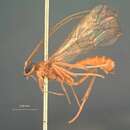pms
nòm ant ël fil


Holmgren’s original publication (Holmgren 1856) is often cited as 1855 (e. g. Townes 1970). Carlson (1979) gives the actual data of publication as 1856. Yu and Horstmann (1997) and Yu et al. (2005) give a publication date of 1855 under Perilissus, but erroneously attribute authorship to Foerster. They do, however, give 1856 as the actual date of publication for Holmgren’s first publication on Perilissus. Holmgren (1856, 1857) apparently described Perilissus in two separate publications. Viereck (1912), perhaps unaware of this, specifically designated Mesoleptus limitaris Gravenhorst as the type species of Perilissus, stating that several species were originally included in Perilissus by Holmgren (1857). Townes (1945), however, without mentioning Viereck’s designation, gives the type species as “Mesoleptus filicornis Gravenhorst. Monobasic” and filicornis has been recognized as the type species in all subsequent publications.
Perilissus Holmgren, 1856 and Spanotecnus Foerster, 1869 have the same type species and Spanotecnus must therefore be treated as a junior objective synonym of Perilissus. Gupta (1987) suggests that this synonymy should be attributed to Dalla Torre (1901). Dalla Torre (1901) treated both as valid genera, but listed Perilissus sensu Holmgren and recent authors as one of the synonyms under Spanotecnus.
Spanotecnus Foerster (1869): 197. Type species: Ichneumon filicornis Gravenhorst, 1820. Based on subsequent designation by Viereck (1914), chosen from among the four species that were first included in Spanotecnus by Thomson (1883). Synonymy indicated by Dalla Torre (1901).
Ichnaeops Foerster (1869): 197. Type species: Perilissus lutescens Holmgren, 1857. Designated by Perkins (1962). Synonymized independently and almost simultaneously by Townes et al. (1961) and Perkins (1962).
Polyoncus Foerster (1869): 197. Type species: Tryphon erythrocephalus Gravenhorst, 1829. Based on subsequent designation by Viereck (1914), chosen from among the three species that were first included in Polyoncus by Thomson (1883). Synonymized by Townes (1945).
Udenia Foerster (1869): 202. Type species: Perilissus (Udenia) herrichii Kriechbaumer, 1892. Based on subsequent inclusion by Kriechbaumer (1892). Monobasic. Synonymized by Schmiedeknecht (1912).
Exacrodus Foerster (1869): 210. Type species: Exacrodus populans Morley, 1913. Based on subsequent inclusion by Morley (1913). Monobasic. Synonymized independently and almost simultaneously by Townes et al. (1961) and Perkins (1962).
Daugna Seyrig, 1935: 29. Type species: Daugna alluaudi Seyrig, 1935. Original designation. Synonymized by Townes et al. (1965).
Pseudochorus Rao, 1953: 195. Type species: Pseudochorus kuriani Rao, 1953. Original designation. Synonymized by Townes et al. (1961).